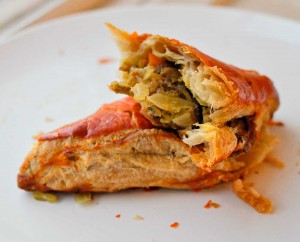Bengali eateries and grocers hide in the heart of Koreatown
You might be surprised to know that the supposed heart of Koreatown, a small strip of Third Street and Wilshire Boulevard between Wilton Place and Vermont Street, does not belong to the Koreatown community, but is listed in the official city map as Little Bangladesh.

Local luxury · Little Bangladesh, ironically located in Koreatown, is home to a slew of Bengali markets and shopping areas, such as Aladin, a small sweets market known only to the local Bengali community. - Sophia Lee | Daily Trojan
Even more surprised were Korean civic groups, who had assumed the three-square-mile urban district west of Downtown which — for three decades has housed the highest density of Koreans outside of Seoul — was already officially Koreatown. That is, until a committee of Bangladeshi businessmen formally filed an application to the city late 2008, requesting the small Bangladeshi-concentrated patch at Third Street be officially designated as Little Bangladesh.
Koreatown activists, disconcerted and indignant, fought to quash an attempt that they interpreted as an encroachment into their front yard. The Bangladeshi community, equally indignant, argued every ethnicity deserves a special place in American soil. It’s a familiar Los Angeles battle: a clash between mainly immigrant groups over a common desire for territorial identity and national pride.
Two years later, Little Bangladesh has earned a blue sign signifying official recognition of its growing Bangladeshi population. Boundaries between Little Bangladesh and Koreatown might have been set in print, but in actuality, the four-block stretch is still an odd jumble of Bangladeshi groceries, Thai BBQ restaurants and Korean boba cafes.
Little Bangladesh still isn’t yet a thriving shopping district like Little Tokyo, nor does it have an ornate welcome gate like Chinatown. It’s a pocket within Koreatown into which you stumble unknowingly, only to realize that the blocky squares and circles of hangul (native Korean alphabet) on signboards and posters on windows have been replaced with florid Bengali script of horizontal lines.
The best places to visit for an authentic bite aren’t the sit-down restaurants but the grocery stores. Authentic Bengali dishes are more often served from steam trays at inconspicuous family-owned stores that double as a cultural center and neighborhood market.
Aladin Sweets and Market, located on Vermont Avenue, is one. Half-shrouded by a tree, Aladin is a small shop known only to the local Bengali community. If you are not Bengali and don’t speak Bengali, you’ll stick out like a sore thumb, but that’s a good thing, because both owners and customers will gladly help you out.
Ask nicely, and they will take you on a little tour around the shop, proudly boasting they store common Bangladeshi products from curry mixes to imported frozen hilsa, Bangladesh’s national fish. They might even show you a Bengali cuisine cookbook (apparently hilsa can be cooked 100 different ways), or a picture book listing all the native fruits and seafood.
At their prepared foods counter, try their shingara, a pyramid-shaped Bengali samosa of spiced potato encased in a rich, chewy piecrust. They also have a puff pastry version, a wonderful mix of onions, vegetables and ground meat nested in a light, multi-layered buttery crisp.
But the star of Aladin is its sweets. Rasgulla is a sticky, deep-fried creamy ball of fresh curd cheese and semolina flour soaked in rose water syrup.
Chom chom is a dense, ultra-sweet log of boiled-down cream and milk mixed with flour, sugar and a touch of saffron. The treat is steamed, soaked in syrup and sometimes rolled in coconut flakes.
Kala jamun is a similar oblong cake except darker brown in color with a scarlet coconut-like filling. All of these sweets are served cold, and most delicious with a cup of strong, bitter coffee.
Swadesh, on Third Street, is another similar market. Like Aladin, it stocks many Bangladeshi products and ingredients, including an impressive showcase of spices and an array of native crackers and cookies. On any given day there will be a small group of Bangladeshi men loitering around, browsing in and out of the store and chatting in their native language.
If you’re not used to Bengali food, you might find some of the dishes excessively oily, but don’t let that turn you off. Expect bold, punchy flavors; Bangladeshi dishes aren’t shy with spices, especially mustard seeds and oils.
Bangladesh has an abundant variety of curries, from eggplant to beef. Make sure to ask for their hilsa curries, a rich, gravy-laden fish dish. The delicate white flesh of the river-caught fish tones down the fiery notes of the sauce, and tastes excellent mixed with rice. Goat biryani comes with long grains of fragrant basmati rice and tender, fall-off-the-bone chunks of goat meat.
Swadesh’s pakoras — crispy, doughy fritters made from different mixtures like onion, cauliflower, potato and chickpeas — are a must-try. Though Swadesh doesn’t fry these deep-fried snacks to order, somehow the batter stays fresh and crispy, with a distinct taste and texture from the chickpea flour coating.
Little Bangladesh is still years away from being a commercial district, but for the Bangladeshi community, it’s about gaining official acceptance and a sense of belonging in a foreign turf with a multitude of races and cultures. At any rate, it is an intriguing gem, one of the many unique ethnic enclaves that make Los Angeles such a distinct and exciting city.
Sophia Lee is a junior majoring in print and digital journalism and East Asian languages and cultures. Her column “Cross Bites” runs Mondays.
